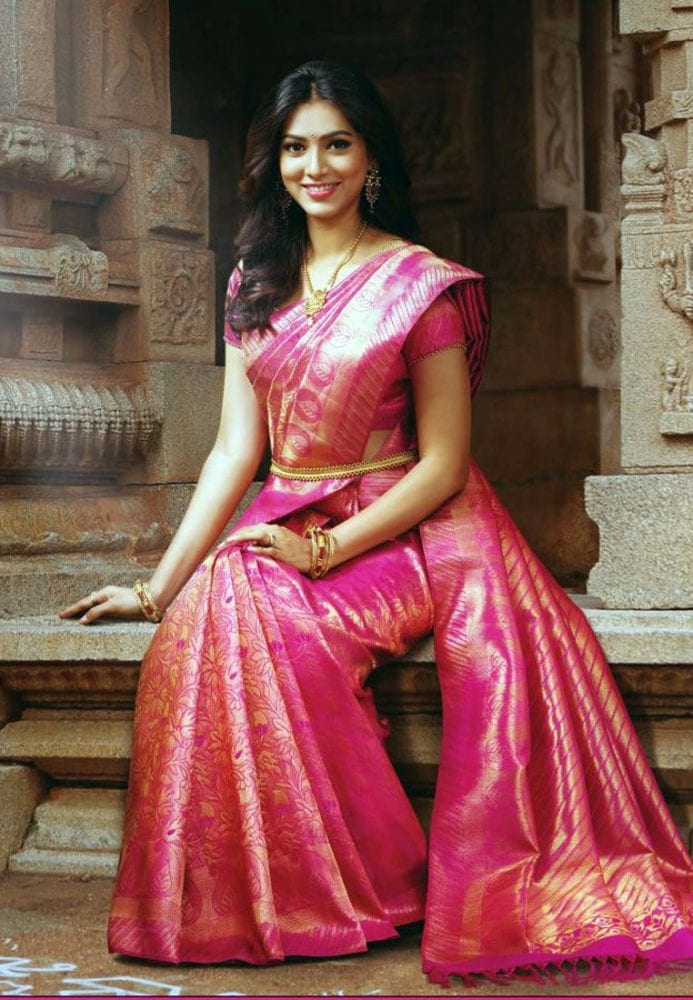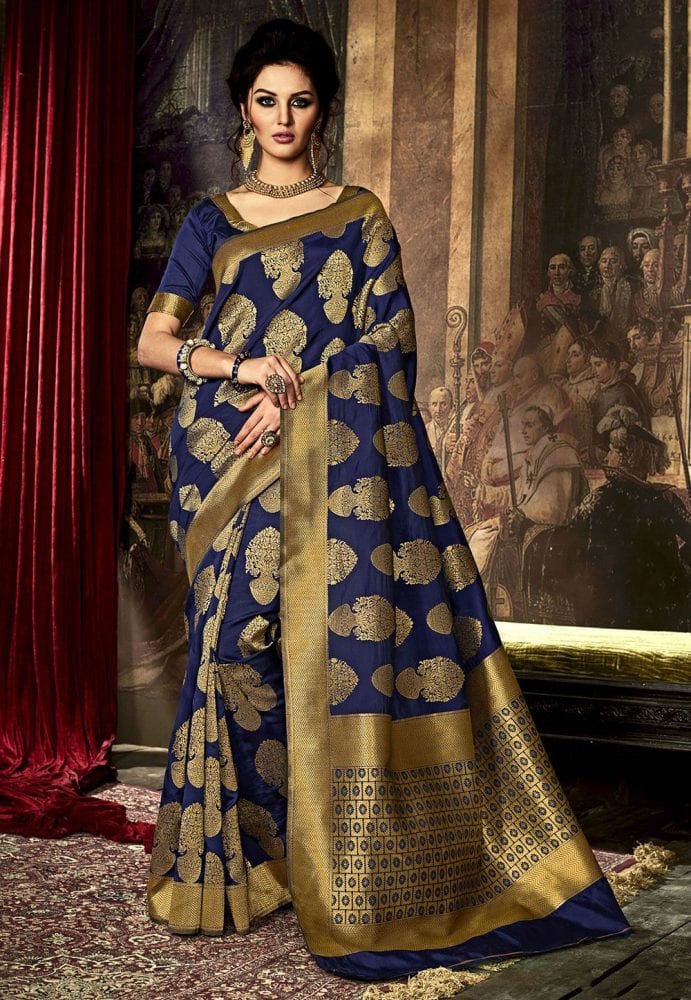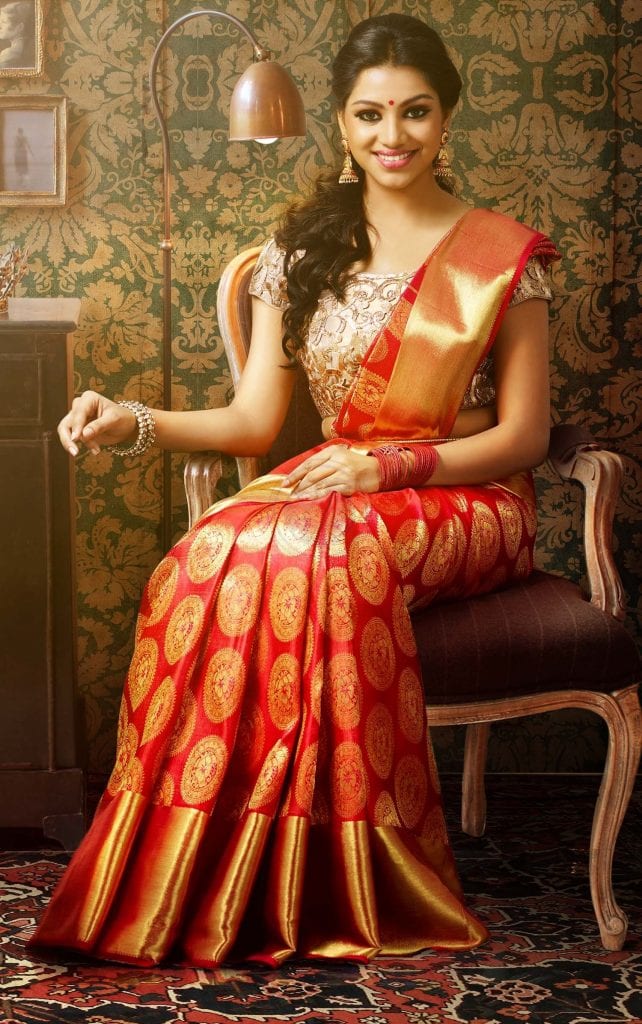The renowned Kanchipuram silk saree is customarily a hand-woven saree made out of mulberry silk, made in the by lanes of the town of Kanchipuram in Tamil Nadu, India. Kanchipuram has eminent sanctuaries included by unmistakable engineering and is otherwise called the ‘City of thousand sanctuaries.’ Verifiably, the starting point of the Kanchipuram Silk can be followed back to around 400 years amid the rule of King Krishna Deva-Raya of the Chola Dynasty, when two noteworthy weaving networks of Andhra Pradesh-the Devangas and the Saligars, moved to this town.
The rich sanctuary culture and the utilization and routine with regards to wearing silk in customs, weddings, and services in this curious old town are said to be the motivation behind why the weaver networks settled here. These two weaving networks were, and still are, only recognized worldwide for their abilities at weaving silk.
Soon people from across the nation started falling in love with the Kanchipuram saris, particularly for its grace and uniqueness. It is fondly worn during the wedding by the brides, but the entire nation started to buy it to wear this graceful masterpiece on various occasions.

Kancheepuram Saree
Kanchipuram Silk Sarees are famously alluded to as the ‘Ruler of Saris‘ a direct result of their gloss, toughness, and flash from the impeccable zari work. Worn over all ages for a wide range of capacities and functions, they structure a much-wanted piece of an Indian Bride’s trousseau and are regularly passed down ages. More often than not, the nature of the sari is reviewed dependent on how overwhelming the sari is. The heavier the sari, the better the quality.
This sari is best depicted as a brilliant silk sari with zari work. Zari is metallic string generally produced using gold or silver and interlaced with the silk to make different themes. Generally, themes for Kanchipuram Saree are intensely drawn from the style and design of the Pallava Dynasty-their sanctuaries, castles and works of art. Be that as it may, these days, even scenes from incredible Indian Epics of Ramayana and Mahabharata can be seen. With the entry of time, one can likewise observe the utilization of ancestral and contemporary themes. Some normal and most loved customary themes are – jasmine bud inside a square or a round casing, particularly known as mallimaggu, or Thandavalam where parallel lines keep running over the body of the Sari.
You will see many ladies wearing this style in parties and important occasions. Kanchipuram silk sarees has a uniqueness about it which no other saree can have. This may be the reason why film stars are seen wearing it so lavishly in grand parties.

Creation of a Kanchipuram Silk Sari
The cautiously handled and arranged mulberry silk string in the picked shading is chosen for the Sari. The silk utilized in Kancheevaram sari is of the best quality, one that isn’t cut or broken. Besides, the silk yarn is a “twofold twist,” i.e., each “string” is really comprised of three single strings curved together which makes it more solid and heavier than other silk saris. The intriguing thing about Kanchipuram Saree is that the weaver initially makes the outskirt, body and the pallu of the sari independently and after that interlocks them firmly to make one piece.
A weaving system known as ‘korvai’ is pursued where the wonderful outskirt and pallu of the sari are an unexpected shading in comparison to the principal body of the sari. At least two laborers are required to make a Kanchipuram following the methods of hree-carry weaving and interlocking weft. A straightforward Kanchipuram sari can take upto 10-12 days and a progressively enhancing one can take around 20 days to plan. Kancheepuram silk sari making done at Kanjivaram Silks. The expense of the sari additionally relies upon the measure of zari joined into the sari. More Zari implies progressively costly the sari. Cleaning is dependably the favored strategy for keeping up a decent silk sari.
The specialty of weaving a bona fide Kanchipuran Silk Sari has been having been passed down as a legacy from the absolute first weavers handpicked by King Rajaraja Chola to weave these Saris, down to the present age of weavers working the 20,000 odd number of handlooms in the Kanchi locale. Since 2005, Kanchipuram Silk has been conceded a GI (Geographical Indication) status for its assurance. In this manner, for a bona fide Kanchipuram silk made in Kanchi locale of Tamil Nadu, India one must search for the GI mark guaranteeing the starting point of the Sari.

How to accessorise Kanchipuram silk saree?
A Kanchipuram Silk Sari was customarily a 9-yard sari that spoke to the way of life of structuring and designing sanctuary stories. Over some stretch of time, these sarees were changed over to 6 yards with gold zari weaving which can be hung in an ordinary way. One must begin with the finish of the sari inverse to the splendid shaded Pallu and begin folding the sari over around the midriff. The creases of the sari are situated along the left leg and whatever remains of the sari is assumed to control over the left shoulder, wrapped by and by round the midriff and tucked on the left side.
The gloss of Kanchipuram Silk can be upgraded and complemented by delightful gold jewelry of your choice. Be mindful about the saree. If it is heavy and is loaded with a lot of designs then sticking to simple jewelry with sharp makeup will be a good choice for you.
Also, pay close attention to your skin tone as well. The colour of saree should complement your body tone and colour as well. Plus the occasion also matters.
Kanchipurn silk is unquestionably the ‘Ruler of silks’ and ownership of such silk, which has been generally handed down from ages of ladies in a family, is, in fact, an entirely alluring expansion to anybody’s wardrobe. If you have not purchased a Kanchipuram silk saree yet, then it’s time to buy one right away.









